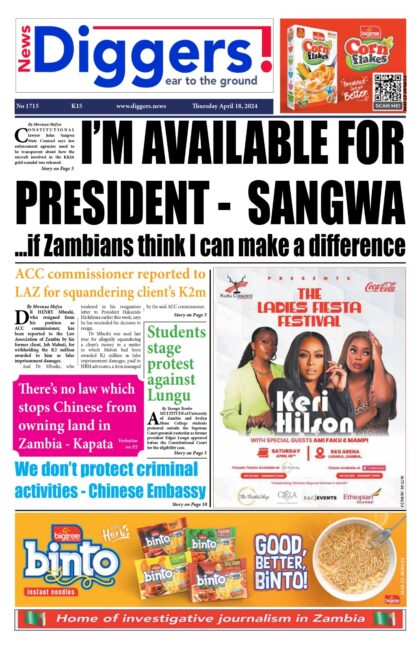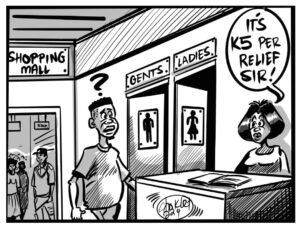The Economist Intelligence Unit (EIU) has projected that the Patriotic Front is likely to retain power in 2021 but warned that government will become increasingly unpopular as a result of economic mismanagement and deepening autocracy.
And EIU says it expects inflation to rise to an average of nine per cent by the end of this year, thereby breaching the Bank of Zambia’s target range of six to eight per cent, after dry weather led to a poor maize harvest, combined with the inflationary effect of depreciation of the kwacha as a result of capital flight in the face of high fiscal risks.
Meanwhile, EIU says it does not expect the International Monetary Fund (IMF) to strike a loan deal with the Zambian government in the medium term, given the planned heavy public borrowing by the State, further projecting that economic policy will remain erratic with sudden changes to the regulatory environment as the government attempts to meet its spending needs.
According to its latest country report generated on September 25, 2019, EIU projected that PF would retain power after the 2021 polls but warned that the country would face substantial threats and simmering popular frustration over economic and political grievances, which might turn violent.
“The run-up to the 2021 legislative and presidential elections will be an especially unstable period, during which a vulnerable government will narrow the political space aggressively and escalate crackdowns. In late August, Zambia’s Registrar of Societies banned the National Democratic Congress (NDC), a small opposition party, which broke away from the ruling PF [after the 2016 elections]. The Zambian authorities are frequently accused by opposition parties of influencing the agency’s decisions. The NDC unsettled the PF in April by winning a by-election for the Roan Parliamentary constituency in Copperbelt Province, a PF stronghold. Its deregistration was therefore seen as an attempt to reinforce the ruling party’s hold on power. Such moves will undermine political stability by feeding into public fears that Zambia is staggering towards autocracy, exacerbating underlying social tensions. Another layer of potential risk emanates from the burgeoning influence of China in Zambia’s affairs, with growing popular suspicion that to secure debt relief, the government plans to sell key state assets to China,” EIU reported.
And EIU projected that Zambia’s fiscal policy between now and the year 2021would remain unsustainable.
“We continue to forecast that spending will remain unsustainably high in 2019-21, albeit declining as a share of GDP from 2021 onwards, owing to stronger nominal GDP growth that year. In 2019-21, expenditure will remain driven by foreign-debt-financed capital outlays and debt servicing. Spending as a whole will drop significantly onwards from 2022, following elections in 2021. Only in 2022, with foreign liquidity pressures mounting will capital spending be cut back, and high debt-servicing costs will continue to crowd out wage spending and subsidies. We expect revenue to fall in 2019 (in nominal terms) as an increase in mineral royalty rates (plus a new top rate), a delay in implementing a new sales tax until January 2020 and the scrapping of VAT rebates for mining companies backfires, with the sector reducing output. However, rising copper prices during 2020-23 will encourage a gradual recovery in production and raise overall revenues during the 2020-23 period (the slowing of the Chinese economy amid escalating global trade tensions represents a downside risk to this forecast),” EIU reported.
“We expect the budget deficit to widen, from an estimated 7.6 per cent of GDP in 2018 to 8.5 per cent of GDP in 2019. Infrastructure spending will keep the deficit wide up until 2021, when we expect it to fall from 8.1 per cent in 2020 to 7.4 per cent of GDP (some of it driven by election-related spending). Steep capital spending cuts should then bring the shortfall down, to 1.5 per cent of GDP by 2023. The deficits will be financed mainly by external loans from China and also domestic borrowing for the recurrent budget. Monetary policy at its August 20th-21st monetary policy committee meeting, the Bank of Zambia kept its policy rate unchanged at 10.25 per cent. The BoZ has proven wary of raising rates owing to the costs to business. However, inflationary pressures are continuing to mount in 2019 as the result of a weakening Kwacha, and we expect a second imminent rate increase, to 10.50 per cent, at the MPC’s November meeting, in order to offset the effects of a lax fiscal position. The rate rises will help to stabiles the kwacha in 2020, and, by 2021, with macroeconomic conditions beginning to normalise (with inflation edging down and fiscal policy tightening), the policy stance will begin to relax, ending the forecast period in 2023 at an average annual rate of 9.25 per cent.”
EIU also projected that economic growth between 2019 and 2023 would be considerably below Zambia’s long-term potential.
Meanwhile, EIU stated that it was expecting inflation to rise to an average of nine per cent in 2019, thereby breaching the BoZ’s target range of six to nine per cent.
“After dry weather led to a poor maize harvest, combined with the inflationary effect of depreciation of the Kwacha as a result of capital flight in the face of high fiscal risks, we expect inflation to rise to an average of 9 per cent in 2019, breaching the BoZ’s target range of 6 per cent to 9 per cent. Price controls on maize have been introduced to counter-inflation, which will hurt farmers but control price rises for food staples. The cost of Zesco’s plans to start importing electricity from South Africa will be added to existing plans to lift electricity tariffs. Although these plans are currently suspended, we expect them to be implemented in late 2019. This would add to inflationary pressures, albeit mostly in 2020, when we expect inflation of 8.7 per cent,” reported EIU.
EIU also projected that high inflation would necessitate a tight monetary stance until 2021, when there would be an unwinding of this position by the Bank of Zambia as inflationary pressures would begin to diminish in 2022-23 as the fiscal deficit narrows.













2 Responses
our leaders have lost trust. HH best option
I don’t believe PF will win elections